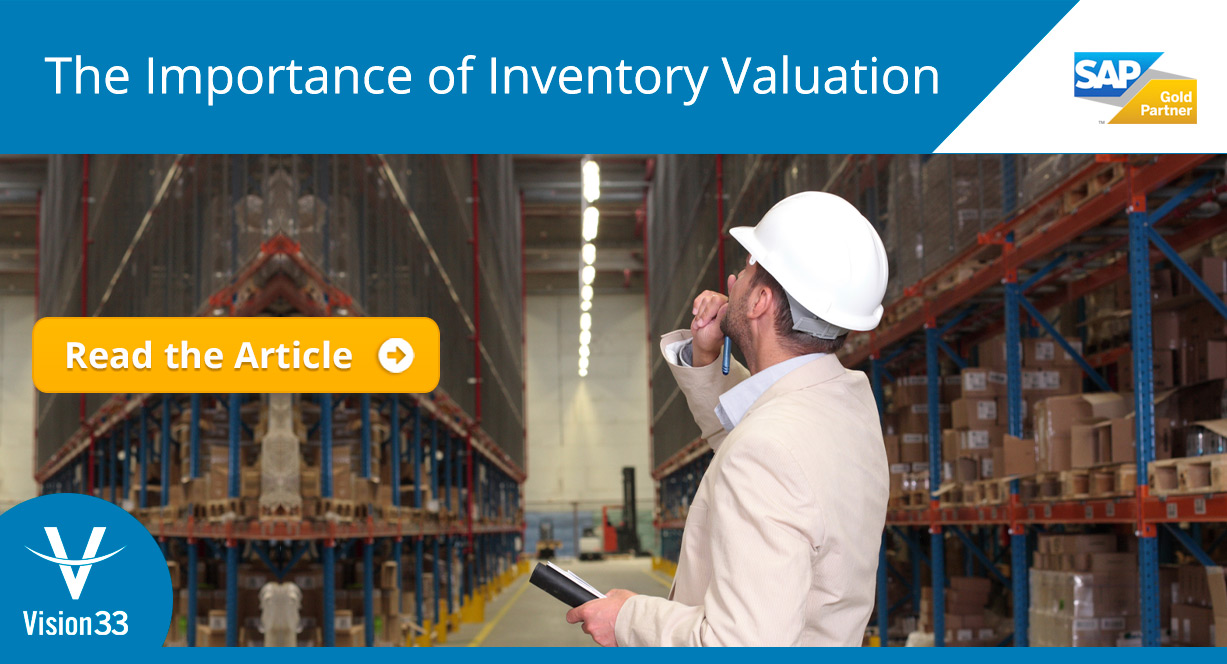How a Cloud ERP Solution Solves Everyday Inventory Management Challenges
SAP Business One[Updated] A cloud ERP solution benefits your business by overcoming inventory management...

July 22, 2016
Blog > The Importance of Inventory Valuation in Distribution
Inventory valuation is often under-emphasized in the small to mid-size business market. With inventory being the largest current asset of the typical distribution business, accurate measurement is important for meaningful financial statements and wise strategic decision-making. The method of inventory valuation that you choose can have momentous implications on profitability, taxes, and strategic planning. Once you set down a specific path with inventory valuation methods, it can be difficult to reverse course. Therefore, it’s important to understand your options and make the right choice from the start.
Inventory valuation methods exist as a vehicle to encapsulate the costs of purchasing, managing, and inventory distribution. Due to the daily variances in managing inventory in high and low volume, value, and complexity, your method should be determined by your business environment. According to GAAP (Generally Accepted Accounting Principles), acceptable inventory valuation methods include:
This is the tracking a specific cost to a specific piece of inventory from start to finish throughout the distribution system. Each piece of inventory is tagged with a specific cost as it enters the system and that cost remains in inventory until that piece of inventory is relieved. While this method is the simplest in concept, it is often the most difficult in practice. This method requires detailed tracking of inventory using serial numbers, lot numbers, or project codes. Because of this detail requirement, it is generally only recommended in the case of low volume, high value businesses that experience high volatility in inventory costs.
FIFO tracks inventory value by layers. Imagine your inventory as a stack of widgets with different costs tied to them. Each time you add inventory, you add it to the top. Each time you pull inventory, you grab from the bottom. Therefore, your oldest inventory item’s cost is the one that is selected when inventory is pulled. The FIFO method tends to weight more heavily towards your balance sheet when costs are trending upwards as your inventory will tend to carry more value than the inventory you sell. The FIFO method is also a useful tool in accounting for obsolescence.
LIFO is opposite of FIFO. Again imagining inventory as a stack of widgets, this time you would add inventory to the top and pull inventory from the top. Therefore, your oldest inventory item’s cost will be reserved as the last one selected when inventory is pulled. The LIFO method tends to weight more heavily towards the income statement when costs are trending upwards as you’ll be getting the most recent value of inventory as you relieve inventory. As costs most-commonly rise, LIFO can be a useful to increase your reported costs and therefore reduce your taxes.
The important thing to remember with both FIFO and LIFO is that they do not tie to specific pieces of inventory. This makes for a complicated answer to the question: “What is one widget worth?” It is also worth noting that volatility in costs can result in a delayed volatility to your financial statements, which can create misleading results and strategic decision-making.
For these reasons, weighted-average cost is becoming more common. Under weighted-average cost, all inventory for a specific SKU maintains the same cost. Each time inventory is added, the value is added to the total value of inventory then split evenly across the quantity. This can insulate both the income statement and the balance sheet from volatility in inventory costing. It also simplifies reconciliation and reporting on inventory levels and costing.
Watch this video clip for a sneak peek of our What Inventory Valuation Method is Right for My Distribution Business webinar.


This recording will also give you food for thought as to whether you are currently using the right inventory valuation method for your business.
Subscribe to our newsletter to receive our latest blog posts, case studies and ERP news delivered straight to your inbox.
[Updated] A cloud ERP solution benefits your business by overcoming inventory management...
Learn about the top issues facing distributors right now—and critical considerations that can help...
Watch the H&S Building Supplies success story to learn how SAP Business One’s all-in-one solution...
Recieve our latest blog posts, case studies, and ERP news
delivered straight to your inbox.